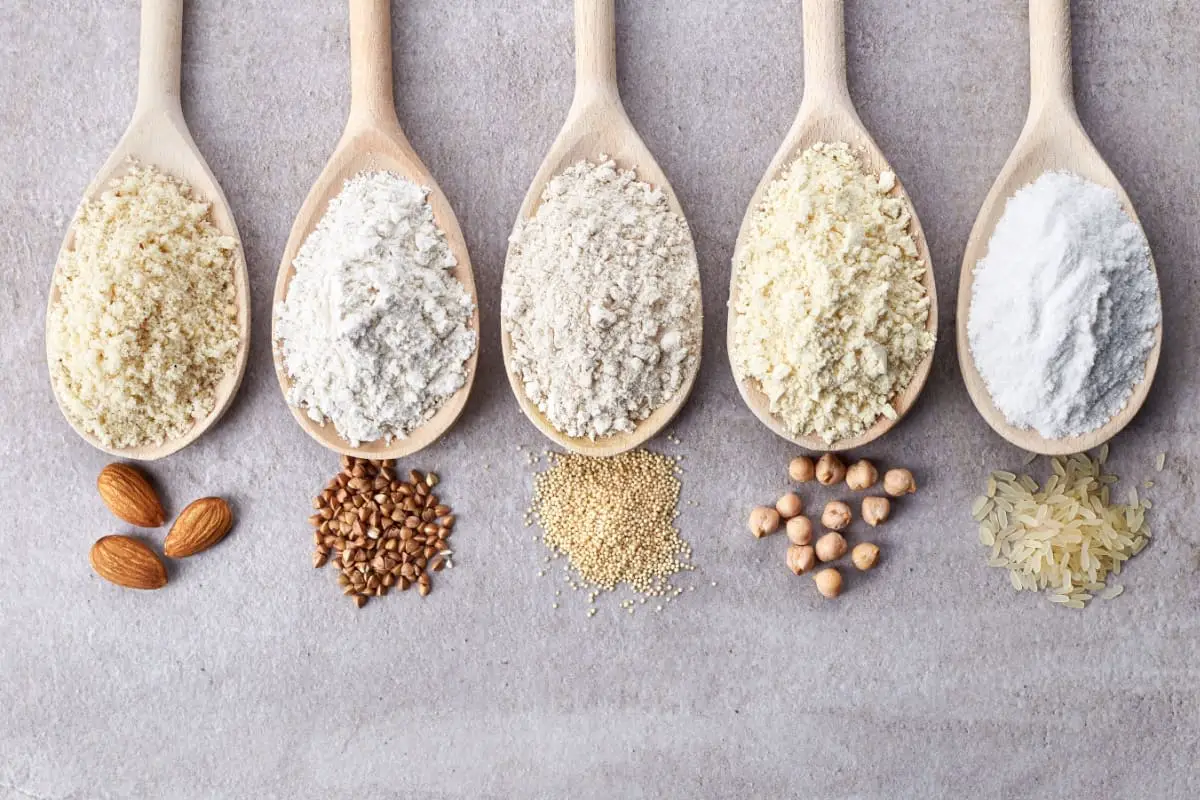Gluten-free flour is a staple in the kitchen. It’s used in baking, cooking, and even making pasta. However, there’s a lot more to gluten-free flour than meets the eye.
There are different types of gluten-free flours out there, each with its unique properties. Some are better suited for specific recipes, while others are better for other uses.
In this article, I’ll explain the differences between gluten-free flours and how they’re made.
What is gluten-free flour?
Gluten-free flours are a great alternative to wheat flour and other grains. They can be used in place of regular flour for baking, but they have many uses outside the kitchen. Here’s what you need to know about them:
It is important to note that gluten-free grains used in the production of gluten-free flour should be grown, transported, stored, processed, and packaged in gluten-free environments.
There are two types of gluten-free flours that we will discuss here: all-purpose and specialty.
All-Purpose Gluten-Free Flour: This type of flour can make bread, pastries, cakes, cookies, etc. It has a neutral taste, so it does not have any specific flavor or a texture like wheat-based flour. The main ingredient in this kind of flour is rice flour, tapioca, and potato or corn starch.
Specialty Gluten-Free Flours: These types of flours will help you achieve a particular result in your baking. For example, some flours will help you thicken a sauce, achieve a crunchy pie crust, or a softer cookie that crumbles in your mouth. The main ingredient in these types of flour will depend on the result you are trying to achieve.
Fresh Ingredients are Key to flavor and outstanding results in Gluten-Free Flour
As with most things in our kitchen, the fresher your ingredients, the healthier, better flavor, and results you will get.
One way to ensure you get fresh ingredients in your gluten-free flour is to make the flour yourself. For this, you’ll need one of two things. You’ll need a source that you know will sell you freshly fine-grained grains and seeds, or you can use a grain grinder mill to mill the grains yourself.
I have geeked out with my choice of the mill. A couple of years ago, I bought the KoMo Classic Mill. I love it. It follows the exact mechanism as the old grain mills, but instead of rocks, they use ceramic plates.
Other cheaper mills also have great results. If you are really into baking, I strongly suggest you get one.
How to Make your own Gluten Free flour mix
Gluten-free flour mixes should not be tricky. It’s not as easy as just adding xanthan gum and tapioca starch, but it doesn’t have to be that complicated either. Let me show you how to make your own homemade gluten-free baking mixes using rice flour (white and brown), potato starch, cornstarch, tapioca starch, and xanthan gum. These are the most common ingredients used in making gluten-free baking mixes.
The links for each product will take you to my preferred brand of flour in Amazon. Another great alternative where I get my gluten-free products is the Gluten Free Mall.
- 1 1/2 cups brown rice flour
- 1/2 cup potato starch
- 1/4 cup white rice flour
- 1/4 cup tapioca flour
- 1 tsp xanthan gum
Note: I use xanthan gum to add elasticity to the flour. If you don’t need this, you can skip the ingredient. If you don’t have xanthan gum, you can replace it with Psyllium husk, ground flaxseed, unflavored gelatin, or guar gum.
All you have to do is mix the ingredients well and store them in a dry place for when you need to use them.
If you haven’t done much gluten-free baking, you need to know that all flours react differently in your baking. I always start replacing the 1:1 ratio of wheat flour with this gluten-free flour mix. You can adjust as you learn how your mixture behaves in your recipes.
Raising Flour Mix
If you need a raising flour mix, all you have to do is add the following ingredients to our previous all-purpose gluten-free flour recipe:
- 2 1/2 teaspoons baking powder
- 1 teaspoon of baking soda
- 1 teaspoon fine sea salt
Directions:
- Mix all the flours, starches, baking powder, and salt in a large bowl.
- Shake the container before using it in case any flours have settled.
- Store this and any other gluten-free self-rising flour blends in an airtight container or a glass jar.
Important: You need to make sure your baking powder and baking soda are fresh, or you won’t get the desired results. Freshness should be a rule of thumb with all your baking ingredients, but especially with these 2.
Here is a great video showing you how to make Almond meal, Oat, and Chickpea flour at home. She uses a blender—an excellent option for when you don’t have a mill around.
How Commercially Available Gluten-Free Flour Is Made
The first commercially available gluten-free flours were rice and corn-based. These are still the most common types of GF flour used today, but there have been many other developments in this area over time.
Today commercial GF flours may also contain teff flour, tapioca flour, sorghum flour, potato starch, garbanzo flour, buckwheat flour, and some may even have nut flour like almonds.
Commercial flours also start by milling the grain into a fine powder. As you can imagine, their mills are just a bit larger than the ones I use.
GF flour is missing the elasticity that gluten provides naturally to gluten-containing flours. Therefore often, these all-purpose flours have xanthan gum, guar gum, or Psyllium husk added as a binder instead.
Self-rising gluten-free flours will include baking powder, baking soda, or similar self-rising ingredients to help flour rise when mixed with other ingredients such as water, vinegar or lemon, and eggs.
Gluten-free flour blend
There are many grains and seeds you can use to create your blend. The different flours will yield different results. Some flours will add a different flavor profile. Others will add a gritty texture, a chewy texture. Others will add elasticity, others color.
I encourage you to play around mixing. It is essential to understand that each flour will be different from brand to brand.
If you are grinding your grains, the region where the grains come from and the type of grain you use will yield different results from people using the same grain family in another part of the world. There are over 40,000 varieties of rice in the world!
What you are baking will determine what your perfect blend will be.

Here is a comprehensive list of the most popular grains used in gluten-free flour mixes:
- White Rice Flour
- Brown Rice Flour
- Almond Meal/Flour
- Amaranth Flour
- Bean Flour
- Buckwheat Flour
- Coconut Flour
- Corn Flour
- Cron Starch
- Millet Flour
- Oat Flour
- Quinoa Flour
- Sorghum Flour
- Teff Flour
- Tapioca Flour
- Cassava Flour
- Potato Starch Flour
- Garbanzo Flour
- Chickpea Flour
- Fava Bean Flour
- Hemp Flour
FAQs
Is gluten-free flour made from wheat?
No, it’s not. Wheat has a protein called gliadin which causes celiac disease. All gluten-containing grains cause celiac disease because they share proteins with wheat. Usually, gluten-free flour is made from white and brown rice, tapioca flour, potatoes starch, and a binder like a xanthan gum.
Is gluten-free flour processed?
Gluten-free flour is processed like regular wheat flour, but it has been made with gluten-free grains and nuts and specially treated to remove all traces of gluten.
What is the difference between flour and gluten-free flour?
Flour is made from ground wheat, while gluten-free flour is made from other grains such as rice, corn, oats, millet, quinoa, buckwheat, amaranth, sorghum, teff, tapioca, potato starch, and arrowroot.
Can you substitute out brown rice flour for white rice flour in your gluten-free flour blend?
Yes, you can use brown rice flour instead of white rice flour in your homemade gluten-free flour blends.
Where can you find the ingredients for homemade gluten-free flour?
You can find the ingredients for homemade flour at any grocery store or online at Amazon.com or my favorite gluten-free market, the Gluten-Free Mall.
How to make gluten-free oat flour?
To make gluten-free oatmeal flour, add 1 cup of oats to a food processor and pulse until it becomes a fine powder. Alternatively, you can also use a grain mill for finely ground, more even powder results.
Is it easy to blend gluten-free flour at home?
Yes, it is easy to blend gluten-free flour at home. You can use any gluten-free flour you want. Feel free to experiment with the list of grains listed in this article. Most grains you will be able to powder using your food processor. Others you will want to use a grain mill. Remember to store your flour in an airtight container.
Why make your gluten-free flour mix?
Making your gluten-free mix is easy and inexpensive. You can use it for baking, making pancakes, waffles, muffins, bread, cookies, cakes, and more! If you make it at home, you can guarantee the freshness of the ingredients you use.
Where to source gluten-free flour?
Gluten-free flour can be found at most grocery stores, health food stores, and specialty shops. You can also buy from Amazon.com or my favorite gluten-free market, the Gluten-Free Mall.
What is a gluten-free flour mix?
Gluten-free flour mixes are used for baking gluten-free bread, cakes, cookies, and other baked goods. They are a blend of gluten-free grains but usually contain rice flour, tapioca starch, potato starch, cornstarch, and xanthan gum.
Do you need a binder in gluten-free flour?
If you want to bake gluten-free bread, anything that requires to rise, or elasticity like tortillas and flatbread, you will want to add a binder to your gluten-free flour mix. If you don’t need leavening, like in the case of cookies, then you can do without the binder.
How do you make gluten-free flour rise?
Gluten-free flour rises best when it has been enriched with xanthan gum or other similar binders. Baking powder, bicarbonate of soda, and cream of tartar are some of the chemical-raising agents that can be used to lighten bread.
I use 1 1/2 teaspoons of baking powder and 1/4 teaspoon of salt for every cup of flour. For some bread, I use 1 teaspoon of yeast per cup of flour.
Alternatively, you can buy gluten-free bread flour. You can purchase online on Amazon.com or at the Gluten-Free Mall, which is where I buy my flours.
Is yeast gluten-free?
Some yeasts do contain gluten. I suggest you always check your labels before buying. I use Fleshman’s Rapid Rise Yeast as it is labeled gluten-free.
What is the shelf life of gluten-free flour?
Most gluten-free flours store-bought or homemade have a shelf life of 1-2 months in your pantry, 4-6 months in your refrigerator, and up to one year in your freezer. If you are storing nut flours such as almond and coconut, you should always refrigerate or freeze.
Conclusion
In conclusion, the production of gluten-free flour is not that different from wheat flour. The main difference is the grains and seeds used don’t contain any gluten. There are two types of gluten-free flour, single grain/seed flour and mixed flours that use two or more types of grains/seeds and may contain binders are raising agents such as baking powder.
It is also important to note that the end-to-end production of the flour can’t come in contact with gluten. Both the ingredients and the process makes the flour gluten-free.
We hope you enjoy learning about gluten-free flour and its uses.



